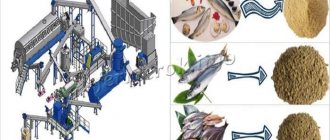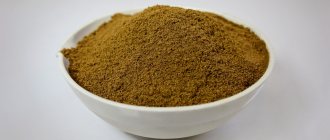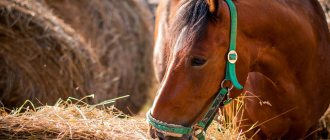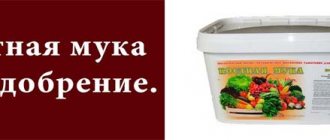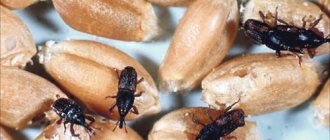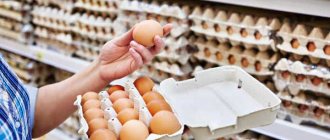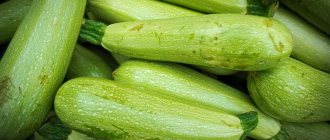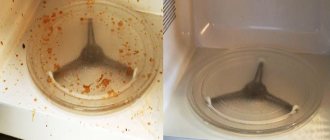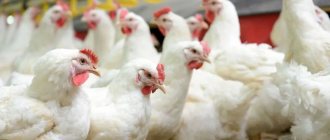Bone and meat and bone meal are products familiar to every farmer. They are obtained by processing the bone and meat-and-bone remains of animals that are not suitable for consumption. They are used as fertilizer for plants and feed additives for farm and domestic animals. To set up your own production of bone meal, an entrepreneur needs to find sources of raw materials in his region, purchase special equipment and form a customer base. More details about all this later in the article.
How is bone meal made?
In crop production, bone meal is valued for its richness in phosphorus and nitrogen. The use of such fertilizer promotes the growth and development of both tubs and garden plants, rapid ripening of fruits, and increased productivity.
In animal husbandry, bone and meat and bone meal are the most valuable sources of protein. They are mixed with feed and introduced into the diet of animals, thereby stimulating intensive weight gain and increasing their productivity.
In appearance, flour is a dry powder of gray or brown color. It has a homogeneous composition and has a specific odor.
Raw materials
The raw materials for the manufacture of this product are mainly animal carcasses that are unfit for consumption. Where can you find the raw materials for making flour on an industrial scale? The best solution is to conclude agreements with local farms for the ransom of dead animals, as well as with meat processing enterprises and organizations whose activities include meat trading, for the purchase of non-food waste.
It is allowed to use as raw materials waste from the meat, fish, leather industry and veterinary confiscation - products rejected during a veterinary examination.
It should be noted that such raw materials accepted by the plant for subsequent processing are infectious and dangerous. In this regard, its delivery to the plant, storage and further use must be carried out in compliance with precautions and personal prevention.
Production stages
Raw materials entering the plant first undergo veterinary control. After this, the raw materials are cut and crushed in special crushers, then, using conveyors, they are loaded into vacuum boilers, where they are subjected to thorough heat treatment - cooking at temperatures up to 130 ° C and pressure up to 0.4 MPa.
The boiled mass is fed through a screw conveyor into a special apparatus, which grinds it to a homogeneous consistency, as a result it becomes similar to minced meat.
Next, this substance enters a centrifuge, where, under the influence of centrifugal force, excess moisture and fat are removed from it. The water-fat emulsion released during the process ends up in a settling bunker, and the meat-and-bone mixture is sent to a drying unit.
After drying, the mass enters the crusher, is crushed, and sterilized. The final stage of production is packaging and packing of finished products. Flour is loaded into bags with a polyethylene layer. The shelf life of this product is six months. If it needs to be increased, special antibacterial ingredients are added to the flour.
Sources of raw materials
Meat and bone meal is a multifunctional additive used in agrochemistry as a fertilizer, and when breeding poultry, cattle and other farm animals - as a food additive. Based on the name, it is obtained from the meat and bones of animals. The raw materials for its production are crushed, then boiled, then dried and finally ground.
Meat waste
The main consumers are agronomic farms. Meat and bone meal contains the following important components:
- Phosphorus;
- Calcium;
- Potassium.
Due to the high content of these substances, flour is actively used when feeding plants.
Meat and bone meal is also used when feeding domestic animals for rapid growth. It contains the following components:
- proteins from 20%;
- fats from 10%;
- ash from 25%;
- water no more than 7%.
No production cycle can be completed if the enterprise does not receive the required quantities of raw materials for the manufacture of products. The main types of raw materials for the production of meat and bone meal are:
- Unused waste from meat processing plants.
- Unused waste from fisheries.
- Carcasses of livestock that died not due to infectious diseases.
- Meat products confiscated due to illegal import.
- Unliquid stock of chain store products.
Let us briefly describe the main sources of raw materials:
- Slaughterhouses, where animal body parts are pre-butchered before being sent to a meat processing plant;
- Meat processing plants and fish farms engaged in food production.
An important point is that all raw materials, regardless of their type and source of receipt, must have the necessary documents. The main one is a veterinary conclusion about the absence of infectious diseases.
Premises and equipment
The project for the construction of a plant for the production of meat and bone meal must be approved by state and veterinary authorities. At the same time, when choosing a site for the location of such an object, it is necessary to convene a commission, which should include representatives of veterinary services.
The territory of the plant must be located at least one km from residential buildings and three km from livestock farms. There should be a solid fence along the perimeter with green plantings.
The territory should be divided into two isolated zones: unfavorable (for receiving and preliminary preparation of raw materials, disinfection of machines) and safe (for processing raw materials, storing finished products, etc.).
The plant must have a sewerage system for wastewater disinfection.
Important! A mandatory event when starting production is the assessment of working conditions and certification of workplaces.
Production premises must be high (at least four meters in height) and light, the floors must have a waterproof coating. The finishing of the walls (cladding) must be such that they can be treated with special cleaning and disinfecting solutions.
Mandatory conditions are the presence of a supply and exhaust ventilation and heating system.
Equipment for the production of bone meal
The production process in modern factories is ensured by automated lines. Lines for the production of bone and meat and bone meal differ in productivity, installed and consumed power, steam and water consumption, overall dimensions and, accordingly, cost.
A line with a capacity of up to three tons per shift can be purchased for approximately 3.5 million rubles, from three to five tons per shift - for six million rubles. It is useful to learn how to get a grant to start a business and what purposes it can be used for.
The kit usually includes:
- Storage hopper
- Power shredder
- Crusher
- Digester
- Centrifuge
- Pump
- Drying unit
- Fat sedimentation container
- Conveyors of different lengths
Two to three people per shift are required to work on the line. Packing of finished products is carried out manually.
Among the Russian manufacturers of equipment for the production of bone meal, we can highlight the following: “Askond-prom”, “NaftaEco IK”, “EcoMax”. All of them have established themselves as reliable manufacturers; some of these companies offer equipment for leasing.
Workshop technical equipment
Let us examine in more detail the technical equipment for the production of meat and bone meal.
- The resulting raw materials must be stored under conditions that prevent them from spoiling. Accordingly, an industrial refrigerator is needed. The cost of building a refrigeration room depends on the equipment manufacturer, overall dimensions of the room, cooling power and temperature. New equipment costs from 200,000 rubles. Used equipment that will be used to get started can be found for around 60,000 rubles.
- Crushing is the first stage of raw material processing. It will require an industrial crusher. The cost of such a crusher ranges from 150,000 rubles for a low-power and used crusher to 1,000,000 rubles for a new powerful automatic crusher.
- The next stage of production is cooking the raw materials. For this you need an industrial boiler. New Russian-made boilers cost from 650,000 rubles. Not new boilers can be purchased from 250,000 rubles.
- After cooking, the raw materials must go into a centrifuge for drying and degreasing. The cost of such a centrifuge starts from 500,000 rubles for used equipment.
- The last technological stage before obtaining the finished product is final drying and crushing to the consistency of flour. You will have to spend from 200,000 rubles on this equipment if you choose not new installations.
- The final stage is packaging of finished products. Here you will need a device for packaging in consumer containers. Depending on its type, the composition of the equipment varies, but the minimum investment is 150,000 rubles.
Workshop equipment
We have described only the basic equipment. In addition to the above, you need to take care of such types of equipment as:
- conveyors for supplying raw materials;
- juice vapor condensers;
- equipment for fat processing;
- pumps for pumping viscous masses;
- tanks for storing semi-finished products and technical fat;
- mixers for mixing various additives.
The most ideal option in terms of compatibility and automation of equipment would be to purchase a ready-made line for the production of meat and bone meal. The cost of such a line starts from 5,000,000 rubles and reaches 40,000,000 rubles, depending on the tasks assigned.
Finance
It is difficult to say how much it will cost an entrepreneur to open a plant for the production of meat and bone meal. The availability of suitable territory and production space will play a decisive role in drawing up the budget. One option is to rent the building of an abandoned facility for a long time and carry out the necessary repair work, and a completely different option is to build a plant from scratch.
The opening budget should include costs for the acquisition of vehicles, purchase, delivery and installation of main production and auxiliary equipment, costs for preparing the legal framework (paperwork, concluding contracts with suppliers, obtaining approvals from supervisory authorities, etc.). It is useful to find out which is better - an LLC or an individual entrepreneur - for production.
The current expenses of such an enterprise include:
- Expenses for the purchase of raw materials
- Transport costs
- Expenses for labor, utilities and communication services
- Costs of container and packaging material
- Advertising expenses
- Taxes, etc.
On average, the cost of meat and bone meal is about 15–20 rubles. per kilogram. The wholesale price varies from 18 to 30 rubles. per kilogram. It largely depends on the quality of the product: the content of crude protein, fat, water, ash and nitrogen-free substances. The higher the protein content, the higher the final cost of flour.
In addition to the flour itself, you can also sell a by-product of production - technical fat, which is also in demand.
Technology and production lines for meat and bone meal
For bright bone greaves and dry bones, the V6-FDA crushing plant is used to transport the finished product through pipelines at a distance of 100 m. The installation consists of crushers for coarse fine grinding, a blower, two cyclones with storage hoppers. The crushers are connected to each other by a hopper.
The Y8-FDB crushing and sieving installation is designed for crushing and sifting defatted and dried paren bones when obtaining feed meal. The integration of a hammer crusher and a screen makes it possible to comprehensively solve two problems - grinding and sifting, eliminating the use of a vehicle to transfer material from one operation to another, reducing the footprint and the number of electric motors due to their installation on one frame.
Based on the modernization of the Ya8-FDB installation, the UDP-750 crushing and sifting installation was developed, which completely borrowed the design solution for aggregating two devices for grinding greaves and sifting flour. Fat-free and dried bone is used as raw material.
The crushed greave is sieved to obtain feed meal in the form of a finished product. The efficiency of sifting depends on the granulometric composition of the original greaves, its physicochemical properties, specific load, sieve dimensions, material of its threads and its live section per unit area, frequency and radius of the oscillation trajectory.
For sifting feed flour, an A1-DSM machine and PB-1.5 burat are used. The A1-DSM machine consists of a rigid welded frame, a working box with a sieve, and a drive. The crushed greak is fed into the working box through a pipe with a diameter of 150 mm.
Burat PB-1.5 is designed for sifting feed flour. Its screening drum is made up of five flat sieves with cells with a diameter of 3 mm. The flour, having passed the sieve, spills through magnetic catchers, which are periodically cleaned through hatches on the drum body, and is unloaded from the installation by a screw unloader.
Treatment of meat and bone meal with antioxidants. To slow down the oxidative processes in fat, feed meal from meat and bone raw materials is treated with antioxidants, for which synthetic oxidizing agents santoquin, ionol and niflex-D are approved for use. Flour is processed in two ways: by adding it to raw materials or to wet greaves before drying, and by adding it to finished flour. Meat and bone meal is treated with santoquine or ionol at the rate of 0.02%, and with niflex-D at the rate of 0.012% of the weight of fat contained in the raw material or flour.
If, during the processing of fat-containing raw materials, an antioxidant is introduced into the meat and bone greak after draining the fat, then the required amount of antioxidant is determined based on the fat standard established for meat raw materials with a low content. The antioxidant is introduced into a vacuum boiler. This method allows you to simultaneously treat the fat rendered from the raw material and the fat remaining in the greak with an antioxidant. Uniform distribution of the antioxidant in the product is ensured by mixing the mass in the boiler.
Packaging, labeling, storage and transportation of feed meal. The produced feed meal is packaged or stored in bulk. It is packaged in three- and four-layer paper unimpregnated bags or used dense, durable, clean and disinfected fabric bags. The weight of one bag of feed flour should not exceed 50 kg. Once filled, the flour bags are sewn, tied or otherwise closed and labeled.
A bulk feed flour storage system consists of the following structural elements: storage bins equipped with unloading augers, which, when rotated in the opposite direction (reversing), can be used to mix flour in the bins. A greaves normalizer hopper can be used as storage bunkers. Its capacity is assumed to be equal to the shift output of the workshop. The bulk storage system includes transport loading equipment, including a feed auger, a bucket elevator and a dispensing bag with unloading windows, equipped with remote-controlled gates; transport unloading facilities, including an unloading auger, a bucket elevator and a specially equipped vehicle for bulk transportation of flour.
In domestic and foreign practice, the method of accumulating and transporting feed flour in soft specialized reusable containers has become widespread. They are made from rubber-textile non-woven single-layer nylon material RN-1K or rubber-cord materials.
Approximate norms for the yield of feed flour and requirements for its quality. The usual average annual norms for the yield of feed flour are 19...22% of the mass of pulp raw materials and low-value by-products, 21...24% of the mass of confiscated goods.
1.3
Review of modern technological lines for the production of meat and bone meal and their features
In our country and abroad, various lines are used for the production of dry animal feed, feed and technical fat: lines K7-FKE, B2-FZHL, Centrimille lines from Alfa-Laval (Sweden ), Stork Duke (Netherlands), etc.
We will look at some of them:
The K7-FKE line is designed for the production of meat and bone meal and technical or feed fat from a mixture of raw meat and bone.
The feed meal production process on this line includes: processing of raw materials in a thermal apparatus (sterilization, partial
degreasing, preliminary dehydration), grinding of cooked raw materials, drying, cooling and grinding of greaves, packaging and weighing of feed flour, labeling of containers (Figure 1). The mixture of pulp and bone raw materials is crushed to a size of 50 mm and fed by an elevator into a screw dehydrator.
In it, the raw materials are subjected to heat treatment at a steam pressure inside the jacket and in the screw shaft of the apparatus of 0.35...0.4 MPa for 20 minutes. The product temperature at the outlet of the apparatus is at least 90 °C.
During the cooking process of raw materials, up to 3% fat, 20% water in the form of broth and up to 25% juice steam are released. The water-fat mixture is continuously discharged through a grate in the bottom of the apparatus into a grease trap, above which a mesh with holes with a diameter of no more than 3 mm is installed. Protein losses with broth reach 0.6% of the weight of the greaves. The welded raw material enters a hammer crusher, where it is crushed to particles less than 25 mm in size ,
and then it is fed through a heated elevator into a three-section dryer.
Drying lasts 40...45 minutes, during which secondary steam is released, which is discharged to the condenser, and the dry product with a mass fraction of moisture of 9...10% is fed into the screw cooler by the elevator. Pre-cooled feed flour is crushed in a hammer crusher (grid opening diameter is 4 mm) . Feed flour is sifted through a sieve with holes with a diameter of 4 mm ,
cleaned of metal impurities using a magnetic trap, packed in craft bags or transferred for bulk storage.
The yield of finished products from a mixture containing 70% pulp and 30% bones is up to 28%. The productivity of the K7-FKE line is up to 600 kg of bone meal per shift.
Replenishment of the K7-FKE line with equipment for degreasing greaves allows it to process fat-containing raw materials without restrictions.
To intensify the heat treatment process and eliminate losses, it is proposed to use hot fat as a coolant, as a result of contact with which moisture intensively evaporates, fat is melted and non-food raw materials are disinfected. The use of a hydrophobic coolant such as fat prevents the transfer of proteins into it and thereby prevents the loss of dry matter. This method is used in the B2-FZHL line of installations from Stork Duke (Netherlands).
Figure 1 – Line K7-FKE: 1 – chopper; 2 - elevator; 3 - dehydrator; 4 - grease trap; 5, 10 — crushers; 6, 8 — heated elevators; 7 - drying unit; 9 - cooler.
Line. This line processes non-food
raw materials of animal origin containing 20...50% raw bone (Figure 2).
The raw materials enter the receiving hopper, divided into two zones: for bone and pulp waste. The receiving hopper is located below floor level and is equipped with three augers that move the raw material to an inclined auger, which feeds it into the crusher. The crushed product flows by gravity into an intermediate storage bunker, from which it is fed by an inclined screw conveyor into a horizontal heated closed-type screw for loading into a sterilization apparatus (equacocker) with a steam jacket. An equacocker is a horizontal cylindrical boiler having a well-installed mixer with vertical blades and pipes. They are mounted on two hollow partitions located on a hollow shaft and dividing the container into three zones. The partitions have holes for the movement of raw materials from one zone to another. The processed product enters the lower part of the equacocker and continuously moves towards the unloading side, while the fat is heated to 130...150°C from a steam jacket and a steam-heated mixer for 2...3 minutes. As a result of contact of raw materials with hot fat, moisture evaporates, the resulting vapors pass through a cyclone, where solid particles are separated from fat droplets. A paddle regulator resembling a scoop wheel is installed in the tail section of the equacocker. With its help, the mixture of hot fat and heated material is removed from the last compartment of the sterilization apparatus and sent to the drainage device. The latter is a trough with holes 2 mm in diameter ,
through which the fat flows into the receiving tank. An auger is installed in the trough, moving the greak towards the magnetic separator. Next, the greaves are fed to the press by a screw conveyor.
The pressed greaves are sent through one of the screw conveyors for re-processing or for the production of feed meal. Raw materials sent for flour production are loaded into an intermediate cooling hopper and then, via a chain bucket elevator, into a rotary crusher (capacity 2t/h).
The resulting flour with a size of 0.5...1 mm enters a vibrating sieve to separate unground particles. The sifted flour is sent to the bunker and, using an auger located in the lower part, is unloaded into containers.
The fat from the storage tank is pumped into a horizontal centrifuge and, after cleaning, it enters the storage tank, while the solid particles from the centrifuge are returned by a screw to the equacocker.
produces lines with a capacity of 5800 and 1500...1800 kg/h for raw materials, 1638 and 400...700 kg/h for meat and bone meal. The average yield of feed flour on the Stork-Duick line is 26...27.5%, technical fat - 18.7% of the mass of processed raw materials with a bone content of about 39%.
The line produces feed flour, which meets the requirements of 1st and 2nd grades in terms of fat and protein content. The fat obtained on this line is classified as 3rd grade due to its dark brown color.
Figure 2 – Line (Netherlands): a – raw material processing area: 1 – receiving hopper for raw materials; 2 - inclined auger; 3 - electromagnet; 4 - crusher; 5 — sterilization apparatus (equacocker); 6 - centrifuge; 7–cyclone; 8 — drainage device; 9 - collection for fat; 10 - screw press; 11 – control panel. b – flour processing area: 1 – chain bucket elevator; 2 - screw conveyors; 3 — intermediate cooling hopper; 4 - screw press; 5 - unloading hopper; 6 - vibrating sieve; 7 - crusher.
The domestically produced V2-FZhL lines are similar in operating principle to the lines (Figure 3).
According to the technological process, the above lines differ slightly from each other, mainly in quantitative characteristics.
The sequence of operations is almost the same: power grinding (40...100 mm), fat extraction, drying (40...45 min), crushing (3...4 mm). In some cases, before drying (K7-FKE), intermediate crushing is used (up to 25 mm). This technology has a number of disadvantages. The main one is that the drying of the product occurs after the medium grinding operation. In our opinion, it is more expedient to first dry the product and then subject it to mechanical processing. But existing drying technologies ensure the efficiency of the process only with a highly developed surface area of the processed product, that is, provided that the material is sufficiently crushed. But existing drying technologies ensure the efficiency of the process only with a highly developed surface area of the processed product, that is, provided that the material is sufficiently crushed. Therefore, it is necessary to grind the “wet” material to prepare it for drying. One way to solve this problem is to influence the volume, rather than the area, of the processed product during the drying process. This opportunity is provided by the use of a microwave field.
Figure 3 – Line V2-FZhL: 1 – thermocatalytic gas reactor; 2 - scrubber for gas purification; 3 - capacitor; 4 — tanks for storing fat; 5 — centrifuge OGSH-502-K-4; 6 — elevators for feeding greaves and flour; 7 — bunkers for bulk flour storage; 8 — horizontal screws; 9 – crusher for greaves: 10 – vibrating sieve; 11– bunker for greaves; 12 — press for degreasing greaves; 13 - settling tank; 14 — drainage device; 15 — sterilization apparatus; 16 - cyclone for separating particles carried away by steam; 17 — inclined screws for feeding raw materials; 18 — power chopper; 19 - electromagnet; 20 - hopper for raw materials
Microwaves have a sterilizing effect against staphylococci, E. coli and other pathogenic microorganisms. In some cases, using microwaves can bring spoiled products to condition. A significant reduction in energy intensity is due to fundamentally different methods of heating the product. When using traditional methods, heat is transferred from preheated air to the product being processed. Microwave drying assumes that the heat source is the product itself and therefore there is virtually no heat loss. In addition, the product is heated throughout its entire volume, which ensures uniform distribution of moisture.
The above suggests the possibility of using microwave drying in the technology of preparing meat and bone meal. Based on this, it is possible to modernize the technological process: microwave drying, power grinding (40...100 mm), fat extraction, crushing (3...4 mm). The advantages of this process are obvious: microwave drying is more economical and of higher quality, energy costs for grinding a dry product are much lower than “wet” ones. As for fat extraction, we carried out studies on the treatment of bone after deboning with a microwave field (with an emitter power of 800 W). At the same time, intense fat release from the bone was observed, which indicates the possibility of solving the problem of fat extraction by using microwave technologies. It is noteworthy that the principle of action on the product of vibrating grease separators used in existing lines and microwave fields are very similar.
Hammer crushers used for final or intermediate grinding have a number of disadvantages. The main one is that during impact processing of the product it is difficult to ensure the required uniformity of grinding. Sieves in crushers guarantee only the maximum particle size, while part of the product simply turns into dust, which is not suitable for use and worsens the environment of the grinding process. In addition, a significant part of the energy expended is spent on performing absolutely useless work on air ventilation in the crusher and unnecessary grinding of the material.
Thus, based on a review of modern continuous lines for the preparation of meat and bone meal, it is possible to propose a new sequence of operations for the preparation of meat and bone meal from boneless bones: microwave drying, pre-grinding, extrusion. Each of these operations is less energy intensive than currently existing ones (energy consumption for grinding will be less, since the raw materials will be pre-dried), and the quality of the product will be higher, due to the reduction in processing time.
2.
Analysis of the quality of meat and bone meal
Feeds of animal origin are assessed based on the indicators laid down in GOST standards for these feed products, as well as veterinary and sanitary requirements for these products. According to GOSTs, these products should not contain general toxicity and pathogenic microorganisms.
The following studies are carried out in veterinary laboratories: determination of the total bacterial contamination of feed; determination of the presence of coliform bacteria; determination of the presence of bacteria from the genus Salmonella; determining the presence of anaerobic bacteria.
Sampling of flour for bacteriological research is carried out with a dry sterile probe into a dry sterile glass jar. Samples are taken from at least five points. The mass of a single sample must be at least 100 g. The mass of the combined sample must be at least 500 g. The combined sample is thoroughly mixed and divided in half. Each part is packaged in a sterile glass jar. One jar is sent to the laboratory, the other is stored at the enterprise until the end of the analysis. When taking samples, reports are drawn up in two copies, which must contain the following data: name of the manufacturer, batch number, type and weight of the product, number of packaging units, date of manufacture of the product and sampling.
A sample weighing 50 g taken from the total sample is placed in a sterile flask or homogenizer glass containing 450 ml of sterile physiological solution and mixed thoroughly for 30 minutes, obtaining a basic tenfold dilution. After settling the suspension for 10–15 minutes, 1 ml of liquid is taken from the supernatant layer with a glass pipette, added to a test tube with 9 ml of sterile saline solution and the next dilution is obtained. Subsequent dilutions are prepared in the same way.
To determine the total bacterial contamination of meat and bone meal, three methods are used: direct counting of microorganisms, quantitative inoculation on solid nutrient media, and titration inoculation.
When directly counting bacteria, 1 g of meat and bone meal is homogenized with 10 ml of sterile saline, the suspension is introduced into counting chambers (hematological or special Petrov-Gauser, Gelber chambers) and the number of microbial bodies is counted in a phase-contrast microscope.
When sown on solid nutrient media, the material is prepared in the same way as for direct counting, and is added either directly to sterile Petri dishes, then poured with melted agar cooled to 45–50 °C, or onto the surface of sterile agar that has already solidified in the dishes. The dishes are placed in a thermostat at a temperature of 37 °C and after 24–48 hours the number of grown colonies is counted, on the basis of which the number of bacteria in 1 g of flour is determined.
The third method is tested. According to this method, 1 ml of each dilution prepared according to the method described above is added to sterile bacteriological dishes and poured into 10–15 ml of sterile, melted and cooled to 45 ° C meat peptone agar. After the medium has solidified, the cups are placed (upside down) in a thermostat at a temperature of 37 °C. The results are recorded on those plates where visual colony counting is possible. The average number of colonies per cup is multiplied by the dilution and the number of bacteria in 1 g of flour is determined. So, if on average there were 25 colonies per cup at a dilution of 1:10,000, then the number of microbial cells in 1 g of flour is 250 thousand.
To determine the total bacterial contamination of meat and bone meal, a reductase method has been proposed, based on the ability of the bacterial enzyme reductase (dehydrase) to reduce the substrate, which is the sodium salt of resazurin, to resorufin with a change in the blue color of the medium to pink. The time of color change determines the total bacterial contamination: after 2 hours - up to 500 thousand, less than 2 hours - more than 500 thousand microbial bodies in 1 g of meat and bone meal. This method is fast - the study requires no more than 4 hours.
Identification of bacteria of the genus Salmonella is based on establishing their characteristic growth on selective media and enzymatic and serological properties.
To do this, a weighed portion of flour weighing from 50 to 200 g is added to a flask containing one of the pre-enrichment media (saline solution, peptone water) at a flour to medium ratio of 1:5. The contents of the flask are thoroughly mixed and placed in a thermostat at a temperature of 37 °C. After 16–18 hours, inoculations are carried out on two (optional) main enrichment media (selenite broth, magnesium medium, Killian, Muller, Kaufman media) in a ratio of 1: 5.
After 16–18 hours of thermostatting at a temperature of 37 °C, the enrichment media are inoculated with a bacteriological loop into cups with solid differential diagnostic media - bismuth-sulfite agar, Ploskirev or Levin media (two cups each), which are placed in a thermostat at a temperature of 37 °C WITH.
The inoculated dishes are examined after 24–48 hours. On bismuth-sulfite agar, S. typhi, S. paratyphi A. grow in the form of small, delicate grayish-green colonies with a black center; S. cholraesuis in the form of green colonies. Colonies of almost all other Salmonella are much larger, dark brown in color with a metallic sheen, surrounded by a light halo, and the color of the area of the medium under the colony is black.
On Ploskirev's medium, salmonella grow in the form of transparent or pale pink colonies; on Levin's medium - transparent, pale, pale pink or pinkish-violet colonies.
When colonies suspicious for Salmonella are detected, three to five of them are inoculated on combined media - Russell, Krumwiede - Olkenitsky in Kovalchuk's modification or three-sugar (lactose, glucose, sucrose), "sloping columns" with urea.
Colonies are sown on a short motley row, including slanted agar and Hiss media with lactose, glucose and sucrose, as well as Hottinger broth for the determination of indole and hydrogen sulfide.
Cultures that are gram-negative motile rods that ferment glucose with the formation of gas, do not ferment lactose and sucrose, do not decompose urea and do not form indole are subjected to serological research - tested in an agglutination reaction on a glass slide with polyvalent adsorbed O-serum.
Detection of motile (except for S. pullorum, S. gallinarum) gram-negative rods that give characteristic growth on elective media that do not ferment lactose and sucrose, ferment glucose and mannitol with the formation of acid and gas (S. typhysuis does not ferment mannitol), give positive an agglutination reaction with polyvalent adsorbed O-serum indicates the presence of bacteria from the genus Salmonella.
3.
Expected structure of the final qualified work
Abstract
Introduction
1. Analysis of the production and economic activities of the enterprise under study
2. Review and classification of modern technological lines for the production of meat and bone meal and their features
3. Introduction of a line for the production of meat and bone meal
4. Life safety during production
5. Economic justification for the project
4.
Characteristics of the enterprise under study
The enterprise under study is OJSC MPK Penzensky.
“Penza” MPK OJSC is one of the largest meat processing enterprises in the Volga region, a leader in the production of raw meat, annually producing about 20,000 tons of sausages. Over thirty years of operation, the Penzensky plant has accumulated extensive experience in the production of high-quality meat and sausage products. The Penzensky meat and poultry plant was put into operation in October 1966 according to a Swedish design for one-story meat processing plants. The basis of the technological equipment was Swedish equipment. The territory of the meat and poultry plant is 14 hectares. Production capacities at the time of launch of the enterprise were: meat and fat shop - 40 tons/shift; poultry shop - 10 tons/shift; technical semi-finished products workshop - 1.8 tons/shift; sausage shop -11; tons/shift.
During this period, the meat and poultry plant produced: sausages - 10,137 tons per year, semi-finished meat products - 4,212 tons per year.
The company exported some types of products abroad - to Cuba, Hungary, Czechoslovakia, Vietnam, etc. In April 1993, the meat and poultry plant was transformed into the Penza Meat and Poultry Plant Open Joint Stock Company.
In February 1997, it was transformed into OJSC Penza Meat and Poultry Plant.
In 1998, the Penzensky Meat and Poultry Plant became part of OJSC Cherkizovo Group, whose investments made it possible to carry out a large-scale reconstruction and modernization of production.
The Cherkizovo Group is one of the largest agro-industrial companies in the Russian meat industry, including 3 main production units - meat processing, pig farming and poultry farming. The Group includes 6 meat processing enterprises, 4 poultry production complexes, 5 pig farms, 3 poultry processing plants, 2 feed mills, 3 trading houses with branches in the largest cities of Russia. The geography of activity covers the entire European part of the Russian Federation, including Moscow and the Moscow region, St. Petersburg, Penza, Lipetsk, Vologda, and other regions.
OJSC MPK Penzensky is the first Russian enterprise certified according to the international food safety system HACCP (“Hazard Analysis and Critical Control Points”). This means that the level of product safety for health meets international standards. The plant operates a quality system of the ISO 9000 series. 2002 – certified according to the quality management system GOST R ISO 9001-2001. The main operating principle of OJSC Meat and Poultry Processing Plant "Penzensky" is concern for the health of the population.
Today MPC Penzensky is a dynamically developing enterprise whose main goal is to satisfy the desires of consumers.
Conclusion
As a result of the research conducted on the topic: “Technologies and production lines for meat and bone meal,” a number of conclusions can be drawn:
1. An important protein component of compound feeds is meat and bone meal. Meat and bone meal is produced mainly in meat processing plants and technical workshops. With the help of good quality meat and bone meal (grade 1 and 2), a balance of essential amino acids in the feed, except for methionine and cystine, is achieved. Properly prepared and with a low content of scleroproteins, protein digestibility is 85-90%.
2. Depending on the content of protein, fat and mineral salts, meat and bone meal is divided into three grades, the rest of its types are produced of the same grade.
3. Flour processing involves carrying out a set of operations aimed at preparing it for grinding. The most significant of them are cooling and the release of metal impurities.
4. In our country and abroad, various lines are used for the production of dry animal feed, feed and technical fat: lines K7-FKE, B2-FZHL, Centrimille lines from Alfa-Laval (Sweden), Stork Duke (Netherlands), etc.
5. The assessment of animal feed is carried out on the basis of the indicators laid down in GOST standards for these feed products, as well as veterinary and sanitary requirements for these products. According to GOSTs, these products should not contain general toxicity and pathogenic microorganisms. The following studies are carried out in veterinary laboratories: determination of the total bacterial contamination of feed; determination of the presence of coliform bacteria; determination of the presence of bacteria from the genus Salmonella; determining the presence of anaerobic bacteria.
Used Books
1. Pogov I.A. etc. Technology of meat and meat products. M.: Agropromizdat, 1988.
2. Sindeev V. A. Processing of meat and offal. - Rostov-on-Don: Phoenix Publishing House, 2000.
3. https://www.pmpk.ru/about/chronicle
4. https://sankorma.ru/veterinarno-sanitarnaya-otsenka-16.html
Where to look for clients
The range of potential customers is determined by the scope of application of bone and meat-and-bone meal. Such products are in constant demand among livestock, fish and poultry farms. It is actively purchased by manufacturers of food for farm animals, as well as manufacturers of food for cats and dogs.
Bone meal will also be of interest to experienced gardeners and gardeners, since it is an excellent phosphorus fertilizer.
Small quantities of goods can be purchased by pet stores, as well as retail outlets selling products for the garden.
To interest potential clients, it is recommended to draw up an attractive commercial offer and develop a flexible system of discounts. This will allow the new manufacturer to quickly get used to and gain a foothold in the market.
Conclusion
The production of bone and meat and bone meal using traditional technology has one significant drawback - high energy intensity. This affects the cost of production and, as a result, the profit of the enterprise. Considering that opening a plant for processing meat and bone waste is a very expensive project, it is recommended that before starting its implementation, everything should be carefully calculated and the market thoroughly studied.
Yuri Muranov Editor-in-Chief of #VZO. Has been working on the site since its inception. All texts go through Yuri before being posted on the site. Quickly delves into the topics on which authors write, including finance, and monitors the quality of published materials.
(24 ratings, average: 4.1 out of 5)
